|
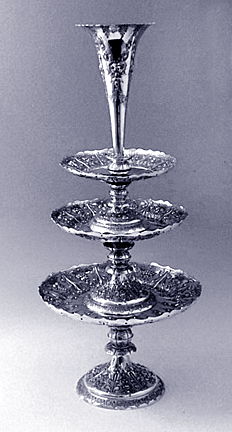 Centerpieces
used as table decorations have varied through the ages. Hosts and hostesses
of the Middle Ages fancied castors with movable figures and trees with
singing birds in the branches. By the dawn of the Renaissance, they were
more likely to show miniature ships and figures of men or animals and silver
statuettes. Porcelain figures and groups enlivened the tables of the Rococo
period. But it was from the late 18th to well into the 19th Century when the
wealthy, who loved to show off to others in their class, that centerpieces
reached new heights. The epergne became the highlight of these centerpieces.
And to help reflect the candlelight on the table, it often sat on a mirrored
glass plateau. Centerpieces
used as table decorations have varied through the ages. Hosts and hostesses
of the Middle Ages fancied castors with movable figures and trees with
singing birds in the branches. By the dawn of the Renaissance, they were
more likely to show miniature ships and figures of men or animals and silver
statuettes. Porcelain figures and groups enlivened the tables of the Rococo
period. But it was from the late 18th to well into the 19th Century when the
wealthy, who loved to show off to others in their class, that centerpieces
reached new heights. The epergne became the highlight of these centerpieces.
And to help reflect the candlelight on the table, it often sat on a mirrored
glass plateau.
Epergnes vs. Plateaus
An epergne is a centerpiece which may be used to serve food, as well. At
first they were long and low, with a bowl in the center and sweetmeat dishes
on either end. Later models often had great height, with a fruit or flower
dish in the center surrounded by hanging baskets. These hanging basket
dishes could be used to serve nuts or candies. Most often, a piece like this
would be used for decoration alone.
The variations of epergnes are endless. Collectors can find them in clear
glass, cut class in all sorts of colors and decorations, as well as both
regular and Sheffield silver plate and, on occasion, sterling silver.
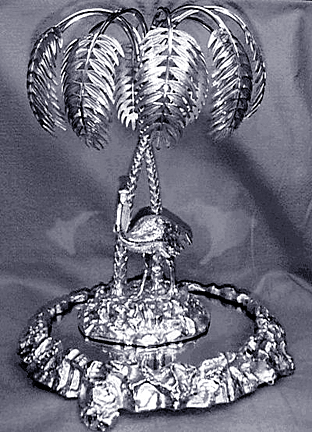 Hostesses
used plateaus, low, flat mirrored glass platforms, on the other hand, to
serve light buffets, cookies and cakes, candies and hors d’oeuvres. They
usually came with five serving bowls, often used for chips and dip. But the
most important utilitarian use for plateaus was to reflect light from
candles on the table. Hostesses
used plateaus, low, flat mirrored glass platforms, on the other hand, to
serve light buffets, cookies and cakes, candies and hors d’oeuvres. They
usually came with five serving bowls, often used for chips and dip. But the
most important utilitarian use for plateaus was to reflect light from
candles on the table.
“Both plateaus and epergnes were symbols of wealth,” said Tom Boswell of The
Main Event of Eustis, Florida, specializing in epergnes and plateaus.
“Craftsmen used exotic animals to decorate them, fantasizing about what they
looked like because they didn’t have any knowledge of them.”
“Centerpieces for fruit and flowers were in great demand in the 19th
Century,” added Boswell. “Epergnes and plateaus allowed the designer to use
his imagination and ingenuity both in the design and workmanship. ”Some
centerpieces featured Roman chariots drawn by cupids. Bas relief ornamented
others. Craftsmen burnished the metal and touched the edges and rims with
gold. Bowls hung from trees and vines or were supported by classic male or
female figures.
Varieties of Epergnes
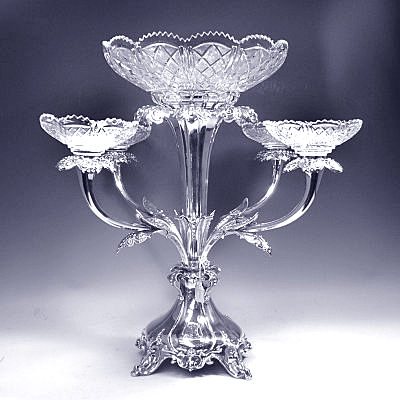 The
typical epergne usually consisted of a tall fruit dish on a metal stand with
two lower matching dishes. One by Reed and Barton consists of a peacock
drawing a chariot which holds a glass container for flowers. Another
features a rowboat holding children, while Meriden Britannia made a delicate
sailboat set on a plateau. A bowl for fruit is set on a pedestal from which
springs a decorative vine-entwined arm holding a cornucopia-shaped glass
vase for flowers. Advertisements in the 1870s showed Gorham's fruit and
flower services featuring Grecian figures, festoons, and gilded bas reliefs. The
typical epergne usually consisted of a tall fruit dish on a metal stand with
two lower matching dishes. One by Reed and Barton consists of a peacock
drawing a chariot which holds a glass container for flowers. Another
features a rowboat holding children, while Meriden Britannia made a delicate
sailboat set on a plateau. A bowl for fruit is set on a pedestal from which
springs a decorative vine-entwined arm holding a cornucopia-shaped glass
vase for flowers. Advertisements in the 1870s showed Gorham's fruit and
flower services featuring Grecian figures, festoons, and gilded bas reliefs.
Craftsmen on both sides of the Atlantic fashioned epergnes, with the
fanciest coming from France. Some feature a number of levels, with several
shelves. Others feature a base consisting of a classic figure or exotic
animal with dish or vases resting atop its head. Most silver companies made
epergnes with sterling as well as gold decoration.
The English made epergnes as early as the 1860s in Sheffield plate. Silver
plate on brass versions made their appearance in the Orient in late 19th
Century.
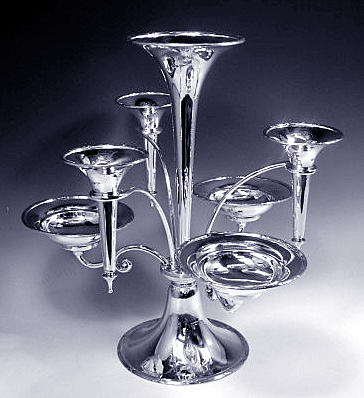 A
writer in the Art Journal in 1875, says: "It was thought that the
introduction of electro-plated ware would lessen the demand for solid silver
objects but this is not so. The production of the artistic designs of the
Meriden Company and other electro-plating corporations appears to have
stimulated the taste for the beautiful and our [U.S.] manufactures of solid
silverware are not only the equal in gracefulness and originality in the
ateliers of England and France, but they are annually rapidly approximating
it in value and volume." He goes on to mention Tiffany, Gorham, and Whiting
& Co. of New York City. A
writer in the Art Journal in 1875, says: "It was thought that the
introduction of electro-plated ware would lessen the demand for solid silver
objects but this is not so. The production of the artistic designs of the
Meriden Company and other electro-plating corporations appears to have
stimulated the taste for the beautiful and our [U.S.] manufactures of solid
silverware are not only the equal in gracefulness and originality in the
ateliers of England and France, but they are annually rapidly approximating
it in value and volume." He goes on to mention Tiffany, Gorham, and Whiting
& Co. of New York City.
The popularity of electroplate lasted until late in the century. The falling
price of silver then made it possible for those who wanted silver to buy
sterling. Although electroplate was first developed in England, American
electroplate is superior to the English product, but manufacturers produced
great quantities of both, which are available for collectors today.
According to Boswell, the weight of most large epergnes demands that they be
made of brass and silver plated. Sterling is just too soft to support the
dishes filled with food., he said.
As ornate silver epergnes lost favor with the public for table centerpieces,
the more simple glass epergnes came into style. After 1850, glass epergnes
became very popular, especially the frosted glass and opaque white glass
ones.
Glass Epergnes and Berry Bowls
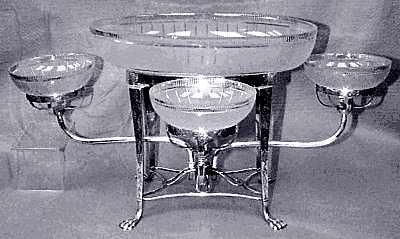 The
Sandwich Glass Factory and the New England Glass Company were two American
firms that made epergnes. The former’s 1870 catalog offered dainty chalices
of fragile glass springing up around a central vase and sometimes cone
shaped glass baskets hanging from metal scrolls. Only the smallest flowers
and most delicate ferns could be placed in these dainty baskets. While these
companies usually made their epergnes of colored glass, they began to
produce ones with clear glass etched bowls, highlighted in gold in later
years. The
Sandwich Glass Factory and the New England Glass Company were two American
firms that made epergnes. The former’s 1870 catalog offered dainty chalices
of fragile glass springing up around a central vase and sometimes cone
shaped glass baskets hanging from metal scrolls. Only the smallest flowers
and most delicate ferns could be placed in these dainty baskets. While these
companies usually made their epergnes of colored glass, they began to
produce ones with clear glass etched bowls, highlighted in gold in later
years.
As the Victorian era came to a close, low bowls of ornamental glass, known
as berry bowls, began to replace the larger epergnes, which seemed so high
and spreading that they seemed more suitable for formal dinners or banquets.
It was a matter of convenience, for one thing, which made hostesses decide
in favor of these glass berry bowls. They could fill them with fruit or
flowers and leave them on the table throughout the meal.
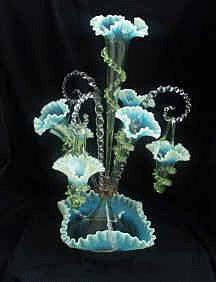 Ornamental
glass manufacturers like Fenton made berry bowls in many colors and types of
glass, with some having two colors of glass fused together so that the
lining and exterior surface formed a contrast in color. For example, they
lined white opaque glass bowls with green, pink, deep rose; blue, amethyst,
brownish-orange, apricot, or yellow glass. They applied a frosted surface to
red glass bowls, giving them a satin-like finish. White satin glass bowls
are scarce. Ornamental
glass manufacturers like Fenton made berry bowls in many colors and types of
glass, with some having two colors of glass fused together so that the
lining and exterior surface formed a contrast in color. For example, they
lined white opaque glass bowls with green, pink, deep rose; blue, amethyst,
brownish-orange, apricot, or yellow glass. They applied a frosted surface to
red glass bowls, giving them a satin-like finish. White satin glass bowls
are scarce.
Though many ruffled-edge epergne berry bowls can be from nine to twelve
inches in diameter, some companies made them as small as four to five inches
across. Glass makers made them in various shapes and with a variety of edges
to go with the overall design of individual epergnes. They gave some a wavy,
plaited edge while on others they used large petals which had a twist in the
glass near the point of each petal.
After a decline in the use of epergnes at the turn of the 20th century, the
makers of carnival glass revived an interest in them by contributing some
colorful variations to the traditional epergne designs. The Dugan Glass
Company of Indiana, Pennsylvania, made a fishnet epergne using carnival
glass. At the same time, the Sowerby Glass Company of Gateshead, England,
made a fountain epergne, with glass holders in a sterling frame. The clear
glass lilies of this epergne had twisted bases with fluted tops that were
marigold in color. One of the rarest carnival glass epergnes, a four-lily
version worth over $1,000 in today’s market, was made by Fenton-Imperial
Glass Company.
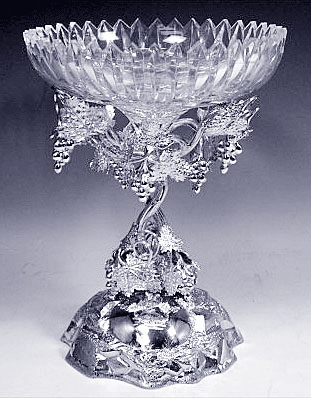 An
elaborate epergne of silver plate, mother-of-pearl Satin glass, and cut
glass is shown in a catalog from 1893. Another shown in the same book is of
silver plate surmounted by a colored glass vase. Epergnes could be made to
order with either metal or glass dishes in the frame. Their cost varied from
$40 to $350 each. However, by the end of the 19th Century, fancy ruffled and
crimped edge berry bowls seemed to be more in favor judging from the greater
number of bowls illustrated in the book. An
elaborate epergne of silver plate, mother-of-pearl Satin glass, and cut
glass is shown in a catalog from 1893. Another shown in the same book is of
silver plate surmounted by a colored glass vase. Epergnes could be made to
order with either metal or glass dishes in the frame. Their cost varied from
$40 to $350 each. However, by the end of the 19th Century, fancy ruffled and
crimped edge berry bowls seemed to be more in favor judging from the greater
number of bowls illustrated in the book.
Visitors to the Columbian Exposition of 1893 in Chicago could purchase
ruffled-edge berry bowls as souvenirs and gifts to relatives and friends.
Women also loved to give these colorful and ornate dishes as wedding gifts.
Often, they came mounted in a silver plated frame and made a striking table
centerpiece, though not as large and elaborate as the traditional epergne.
Identifying Epergnes
Electroplated epergnes are usually marked. Before 1860, manufacturers etched
these marks on to discs, which they soldered to the bottom of the piece.
After 1860, they cut the marks directly into the bottom of the epergne. The
mark included the maker's name and trademark and often the word "triple,"
"quadruple," or "quadruple plate." Any numbers under the name referred to
the pattern. From year to year maker's marks often vary, making it easier to
date pieces.
Early electroplated epergnes are hard to find and so are more valuable.
Makers didn’t mark some of their earlier epergnes with their name. The base
metal on which makers plated the silver partly determines the value. Gorham
always produced high class electroplate and together with Reed and Barton
used a heavy nickel silver base where many other companies used a
lightweight white metal or Britannia. Meriden also used a Britannia base in
the 1870's.
To complement some of the most elaborate epergnes, manufacturers created
plateaus of all shapes and sizes-oval, round, and rectangular-with gadroon
or fluted borders in plain or satin finish. They were also made with
repousse borders and fancy corners to complement the epergne designs.
<
Back to
Antiques Articles
Go to the next antiques article >
|
